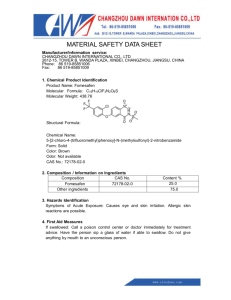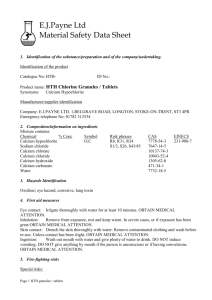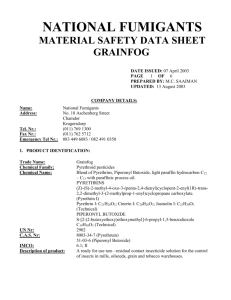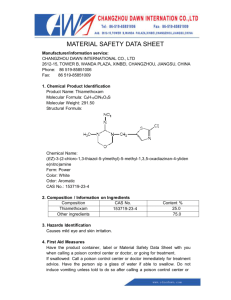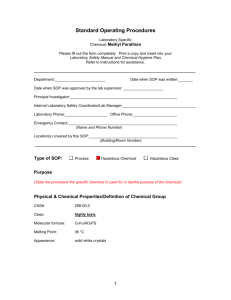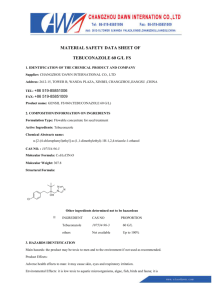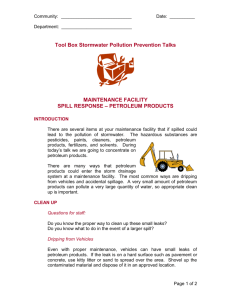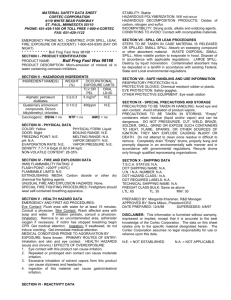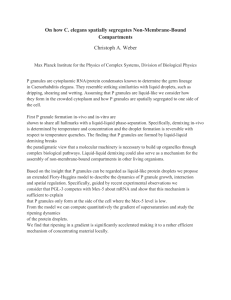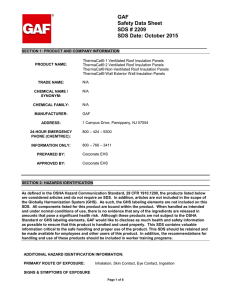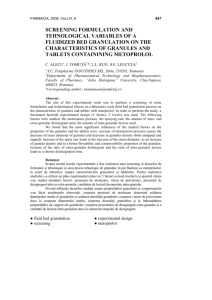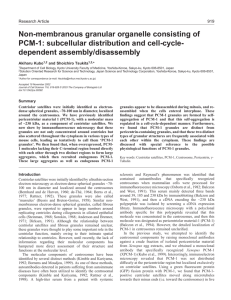Identification of the product
advertisement
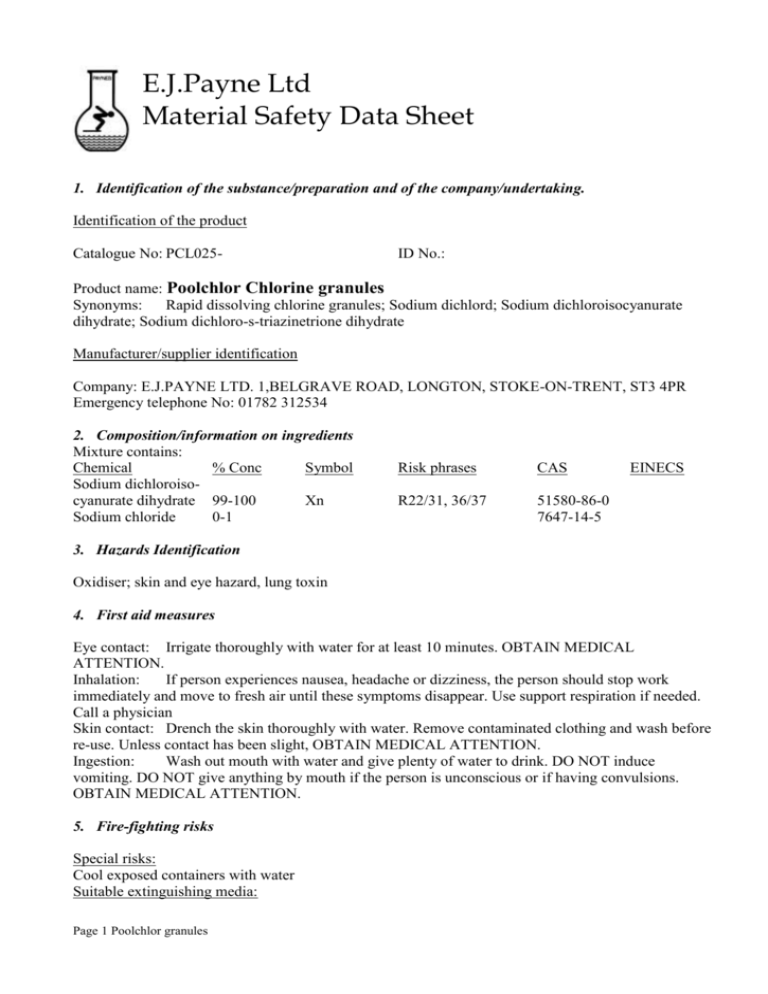
E.J.Payne Ltd Material Safety Data Sheet 1. Identification of the substance/preparation and of the company/undertaking. Identification of the product Catalogue No: PCL025- ID No.: Product name: Poolchlor Chlorine granules Synonyms: Rapid dissolving chlorine granules; Sodium dichlord; Sodium dichloroisocyanurate dihydrate; Sodium dichloro-s-triazinetrione dihydrate Manufacturer/supplier identification Company: E.J.PAYNE LTD. 1,BELGRAVE ROAD, LONGTON, STOKE-ON-TRENT, ST3 4PR Emergency telephone No: 01782 312534 2. Composition/information on ingredients Mixture contains: Chemical % Conc Symbol Sodium dichloroisocyanurate dihydrate 99-100 Xn Sodium chloride 0-1 Risk phrases CAS R22/31, 36/37 51580-86-0 7647-14-5 EINECS 3. Hazards Identification Oxidiser; skin and eye hazard, lung toxin 4. First aid measures Eye contact: Irrigate thoroughly with water for at least 10 minutes. OBTAIN MEDICAL ATTENTION. Inhalation: If person experiences nausea, headache or dizziness, the person should stop work immediately and move to fresh air until these symptoms disappear. Use support respiration if needed. Call a physician Skin contact: Drench the skin thoroughly with water. Remove contaminated clothing and wash before re-use. Unless contact has been slight, OBTAIN MEDICAL ATTENTION. Ingestion: Wash out mouth with water and give plenty of water to drink. DO NOT induce vomiting. DO NOT give anything by mouth if the person is unconscious or if having convulsions. OBTAIN MEDICAL ATTENTION. 5. Fire-fighting risks Special risks: Cool exposed containers with water Suitable extinguishing media: Page 1 Poolchlor granules On small fires use water spray or fog. On large fires, use heavy deluge or fog streams Do not use dry extinguishers containing ammonium compounds. 6. Accidental release measures Spill Mitigation Procedures Air Release Water Release Land Spill Hazardous concentrations in air may be found in local spill area and immediately downwind. If spill material is dry, do not put water directly on this product as a gas evolution may occur. If material is wet transfer to a suitable container, and contact local chemical waste disposal company.. Dust/vapours may be suppressed by the use of a water fog. This material is heavier than water. This material is soluble in water. Stop flow of material into water source as soon as possible.Monitor all exit water for available chlorine and pH. Advise local authorities of any contaminated water release. Containerise all virgin material in a clean dry container using only dedicated equipment to clean material up. Containerise all contaminated material in a clean dry container and remove to a well ventilated area being sure to not seal tightly. Contaminated spill material may become a hazardous waste. Personal Protection for Emergency Spill & Fire-Fighting Situations In case of fire, use normal fire fighting equipment as self contained breathing apparatus. Refer to section 8 for protective equipment in the event of a spill. Other If this material becomes damp/wet or contaminated in a container, the formation of nitrogen trichloride may occur and an explosive condition may exist. 7. Handling and Storage Handling Do not take internally. Avoid contact with eyes, skin or clothing. Upon contact with skin or eyes, wash off with water Storage: Keep tightly sealed. Store in a clean, dry well ventilated area. Do not store at temperatures above 60°C Product Stability and Compatability: Shelf life limitations Incompatible materials for packaging Incompatible materials for storage or transport Indefinite if stored at room temperature Paper, cardboard Other oxidisers, organic materials, reducing agents, acids, bases. 8. Exposure controls / personal protection As appropriate to quantity handles. Respirator: Chlorine cartridge full face piece respirator with dust/mist prefilter Ventilation: Use local exhaust ventilation to minimise dust levels and chlorine gas. Gloves: Neoprene rubber or PVC Eye protection Goggles or face shield Other precautions: Plastic apron, sleeves, boots – if handling large quantities Page 2 Poolchlor granules 9. Physical and chemical properties Form: Colour: Odour: free flowing granules or tablet form product. white chlorine like Decomposition temperature: Begins to lose 1 mole wter at approx, 50°C; second mole water at 95°C; decomposes at 240-250°C Specific gravity 0.96 at 20°C Bulk density: 0.9 – 0.95 pH value: 6.0 – 6.5 (1% solution) Solubility in water: 29% at 30°C Molecular weight: 256 10. Stability and reactivity: Conditions under which the product may be unstable. Temperatures above Begins to lose 1 mole of water at approx. 50°C. Dceomposes at 240-250°C Hazardous polymeristaion Will not occur. Incompatible materials Other oxidisers, nitrogen containing compounds, dry powder fire extinguishers (containing mono-ammonium phosphates), Hazardous decomposition products NCl3,Cl,NO,CO2 11. Toxicological information Harmful if inhaled or ingested. Harmful if exposed to skin and eyes. Signs, symptoms, and effects of exposure. Inhalation Acute exposure may cause: severe irritation to respiratory tract resulting in lung edema which can result in shortness of breath, wheezing, choking, chest pain and impaired lung function. Inhalation of high concentrations can result in permanent lung damage. Eye Exposure may cause severe irritation and/or chemical burns with corneal damage. Impairment of vision is possible. Skin Acute exposure can cause severe irritation, and/or chemical burns. Chronic exposure effects would be similar to those from acute exposure except for effects secondary to tissue destruction. Prolonged skin exposure may cause dermis destruction with impaired skin regeneration at the site of contact. Ingestion Ingestion can cause irritation and/or chemical burns to the gastro-intestinal tract characterised by nausea, vomiting, diahorrea, abdominal pain, bleeding and ulceration. Chronic toxicity via this route is unlikely due to its corrosive nature. Medical conditions aggravated by exposure: Respiratory, cardiovascular and skin diseases Animal Toxicity Acute Toxicity: Inhalation LC50 c. 50mg/l (rats, one hour exposure) Oral LD50 735 mg/kg (rat) Dermal LD50 > 2g/kg (rabbit) Mutagenicity: Not known to be a mutagen Page 3 Poolchlor granules 12. Ecological information Bobwhite quail, dietary LC50 Bobwhite quail, Oral LD50 Mallard duck, dietary LC50 Mallard duck, LD50 Rainbow trout (Salmo gairdneri), 96 hour LC50 static Bluegill sunfish (Lepomis macrochirus) 96 hour LC50 static Daphnia magna, 48 hour LC50 > 10,000 ppm 730 mg/kg > 10,000 ppm 3.3 g/kg 0.22 mg/l 0.28 mg/l 0.55 mg/l 13. Disposal considerations Care must be taken to prevent environmental contamination from the use of this material. The user of this material has the responsibility to dispose of unused material, residues and containers in compliance with all relevant local and national laws and regulations regarding treatment, storage and disposal for hazardous and non-hazardous wastes. 14. Transport information UN-No: NR IMO: NR IATA: NR Correct technical name: ADR/RID: NR IMDG class: Packaging group: Packaging group: NR 15. Regulatory information Labelling according to EEC directives Symbol: Xn Harmful R-phrases: R22-31-36/37 Harmful if swallowed. Contact with acids liberates toxic gas. Irritating to eyes and respiratory system. S-phrases: S2, S8, S26, S41 Keep out of reach of children. Keep container dry. In case of contact with eyes, rinse immediately with plenty of water and seek medical advice. In case of fire and/or explosion do not breathe fumes. EINECS-No.: Not listed Local regulations UK Exposure Limits: None assigned 16. Other information Revision date: 18/09/1994 Date of print: 18/01/2000 Page 4 Poolchlor granules
